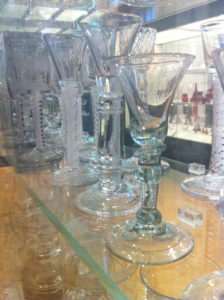
9 July 2013
The shelves of the V&A’s study collection are full to bursting with glass upon glass sitting silently on the shelves. They make for a dazzling display. My research for the glasses I am presenting for display took me to the V&A’s glass room. I scanned the rows of glasses from the time periods I am interested in: the 16th C and the 18th C. The Venetian style glasses are exquisite in their cases, some of the stems styled into intricate works of glass art depicting seahorses and hearts. The English 18th C glasses in comparison are less fanciful and sit more soberly in their own case. Their stems are delicately patterned by air twists or enamelled patterns that are unimaginably complex and catch the eye of the gallery’s visitors.
As well as visiting other collections and scouring art history books I have been deciphering academic science journals to uncover the secrets of the objects I am displaying. We have also carried out some of our own scientific tests on the glass. With the help of conservator Graeme Barraclough and conservation student Douglas Maclennan we analysed the composition of the glasses by X-ray. The results confirmed what my research has already told us, so it was great to know I’m on the right track!
With all my reading, researching and testing I have busily compiled lots of information that I will use to interpret the objects. The culmination of the research I have carried out will be in the crafting of the exhibition labels and the online content, which I hope will bring the objects and their histories alive for the galleries real and online visitors.


